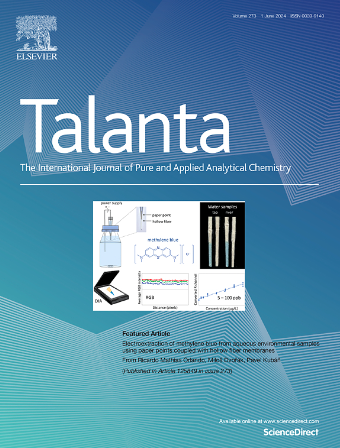用于快速准确检测心肌肌钙蛋白I的无标记电化学发光感应传感器
IF 5.6
1区 化学
Q1 CHEMISTRY, ANALYTICAL
引用次数: 0
摘要
急性心肌梗死(AMI)是心血管疾病患者最常见的死亡原因。心肌肌钙蛋白 I(cTnI)是公认的急性心肌梗死最主要的生物标志物。然而,如何有效提高检测速度和灵敏度是实际应用中的关键问题。在本研究中,我们设计了一种新型电化学发光(ECL)适配传感器,用于快速定量检测 cTnI。该传感器采用自发光的铕基金属有机框架@CdS量子点(Eu-MOF@CdS QDs)作为信号探针。Eu-MOF@CdS QDs 可通过协同效应产生稳定的阴极 ECL 信号。此外,二茂铁标记的配合物被用作淬灭探针,以淬灭 Eu-MOF@CdS QDs 的 ECL 发射。在有 cTnI 存在的情况下,二茂铁标记的适配体特异性地识别 cTnI 并从电极界面上分离后,ECL 强度随 cTnI 浓度的增加而增加。在最佳条件下,该适配体传感器可在 60 分钟内精确分析 1.0 pg/mL 至 1.0 ng/mL 的 cTnI,检测限低至 0.08 pg/mL。结果表明,所开发的 ECL 传感装置在检测血清样品中的 cTnI 以及生物医学分析领域具有潜在的应用前景。本文章由计算机程序翻译,如有差异,请以英文原文为准。

Label-free electrochemiluminescence aptasensor for rapid and accurate detection of cardiac troponin I
Acute myocardial infarction (AMI) is the most common cause of death in individuals with cardiovascular disease. Cardiac troponin I (cTnI) is acknowledged as the most prominent biomarker for AMI. However, the key problem of practical applications is how to effectively improve the detection speed and sensitivity. In this study, we designed a novel electrochemiluminescence (ECL) aptasensor for the rapid and quantitative determination of cTnI. This sensor employs self-luminous europium-based metal-organic framework@CdS quantum dots (Eu-MOF@CdS QDs) as a signal probe. The Eu-MOF@CdS QDs can produce a robust cathodic ECL signal via a synergistic effect. Furthermore, a ferrocene-labeled aptamer was used as a quenching probe for quenching the ECL emission of the Eu-MOF@CdS QDs. In the presence of cTnI, the ECL intensity increased with increasing cTnI concentration after ferrocene-labeled aptamer specifically recognized cTnI and was detached from the electrode interface. Under optimal conditions, the aptasensor demonstrated precise analytical capabilities for cTnI ranging from 1.0 pg/mL to 1.0 ng/mL with a notably low detection limit of 0.08 pg/mL within 60 min. The results show that the developed ECL sensing device demonstrates the potential applications and perspectives for the detection of cTnI in serum samples as well as in the field of biomedical analyses.
求助全文
通过发布文献求助,成功后即可免费获取论文全文。
去求助
来源期刊

Talanta
化学-分析化学
CiteScore
12.30
自引率
4.90%
发文量
861
审稿时长
29 days
期刊介绍:
Talanta provides a forum for the publication of original research papers, short communications, and critical reviews in all branches of pure and applied analytical chemistry. Papers are evaluated based on established guidelines, including the fundamental nature of the study, scientific novelty, substantial improvement or advantage over existing technology or methods, and demonstrated analytical applicability. Original research papers on fundamental studies, and on novel sensor and instrumentation developments, are encouraged. Novel or improved applications in areas such as clinical and biological chemistry, environmental analysis, geochemistry, materials science and engineering, and analytical platforms for omics development are welcome.
Analytical performance of methods should be determined, including interference and matrix effects, and methods should be validated by comparison with a standard method, or analysis of a certified reference material. Simple spiking recoveries may not be sufficient. The developed method should especially comprise information on selectivity, sensitivity, detection limits, accuracy, and reliability. However, applying official validation or robustness studies to a routine method or technique does not necessarily constitute novelty. Proper statistical treatment of the data should be provided. Relevant literature should be cited, including related publications by the authors, and authors should discuss how their proposed methodology compares with previously reported methods.
 求助内容:
求助内容: 应助结果提醒方式:
应助结果提醒方式:


